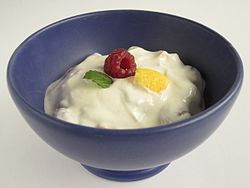Yogurt

A bowl of yogurt garnished with fruit and mint
|
|
| Type | Dairy product |
|---|---|
| Serving temperature | Chilled |
| Main ingredients | Milk, bacteria |
| |
|
| Nutritional value per 100 g (3.5 oz) | |
|---|---|
| Energy | 406 kJ (97 kcal) |
|
3.98 g
|
|
| Sugars | 4.0 g |
| Dietary fiber | 0 g |
|
5.0 g
|
|
|
9.0 g
|
|
| Vitamins | |
| Vitamin A equiv. |
(0%)
26 μg22 μg
|
| Thiamine (B1) |
(2%)
0.023 mg |
| Riboflavin (B2) |
(23%)
0.278 mg |
| Niacin (B3) |
(1%)
0.208 mg |
| Pantothenic acid (B5) |
(7%)
0.331 mg |
| Vitamin B6 |
(5%)
0.063 mg |
| Folate (B9) |
(1%)
5 μg |
| Vitamin B12 |
(31%)
0.75 μg |
| Choline |
(3%)
15.1 mg |
| Vitamin C |
(0%)
0 mg |
| Minerals | |
| Iron |
(0%)
0 mg |
| Magnesium |
(3%)
11 mg |
| Manganese |
(0%)
0.009 mg |
| Phosphorus |
(19%)
135 mg |
| Potassium |
(3%)
141 mg |
| Sodium |
(2%)
35 mg |
| Zinc |
(5%)
0.52 mg |
| Other constituents | |
| Selenium | 9.7 µg |
| Water | 81.3 g |
|
|
|
|
|
| Percentages are roughly approximated using US recommendations for adults. | |
Yogurt, yoghurt, or yoghourt (/ˈjoʊɡərt/ or /ˈjɒɡət/; from Turkish: yoğurt; other spellings listed below) is a food produced by bacterial fermentation of milk.
The bacteria used to make yogurt are known as "yogurt cultures". Fermentation of lactose by these bacteria produces lactic acid, which acts on milk protein to give yogurt its texture and characteristic tang.Cow's milk is commonly available worldwide, and, as such, is the milk most commonly used to make yogurt. Milk from water buffalo, goats, ewes, mares, camels, and yaks is also used to produce yogurt where available locally. Milk used may be homogenized or not (milk distributed in many parts of the world is homogenized); both types may be used, with substantially different results.
Yogurt is produced using a culture of Lactobacillus delbrueckii subsp. bulgaricus and bacteria. In addition, other lactobacilli and bifidobacteria are also sometimes added during or after culturing yogurt. Some countries require yogurt to contain a certain amount of colony-forming units of bacteria; in China, for example, the requirement for the number of lactobacillus bacteria is at least 1 × 106 CFU per gram per milliliter. To produce yogurt, milk is first heated, usually to about 85 °C (185 °F), to denature the milk proteins so that they set together rather than form curds. After heating, the milk is allowed to cool to about 45 °C (113 °F). The bacterial culture is mixed in, and a temperature of 45 °C (113 °F) is maintained for four to seven hours to allow fermentation.
...
Wikipedia
